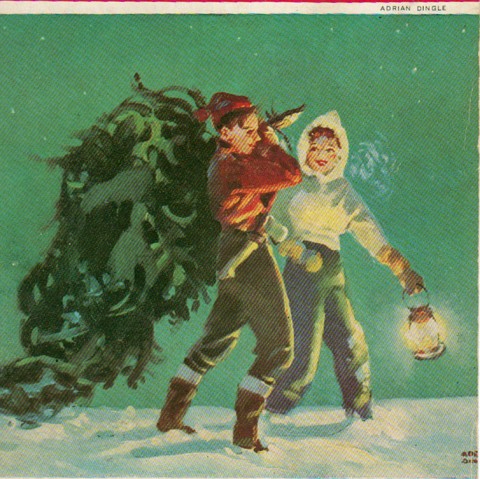
Presents and surprises are one part of Christmas, for some a huge part, but one can’t deny that it’s invariably a pleasant experience to get a gift, especially an unexpected one.
My friend and fellow WECA book collector, Walter Durajlija, just a little while ago was able to discover and acquire a collection of just over 45 WECA comics(almost all Bell Features books) here in the province. My understanding is that this was part of a larger purchase that also included two original art pages from the WECA period featuring Harry Brunt’s Buzz and his Bus series which I can identifying as being from Wow Comics 25.
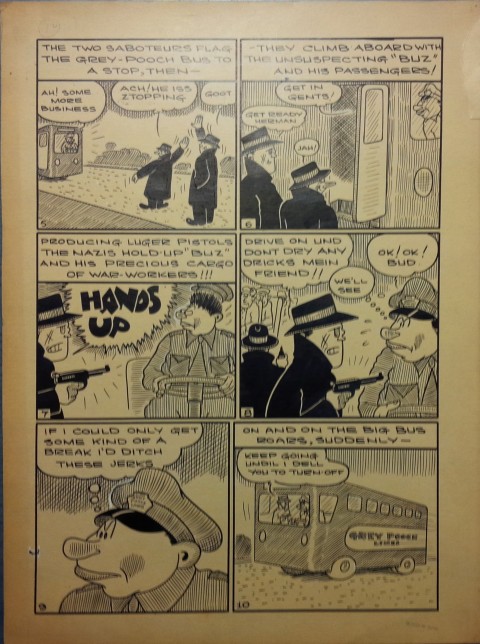
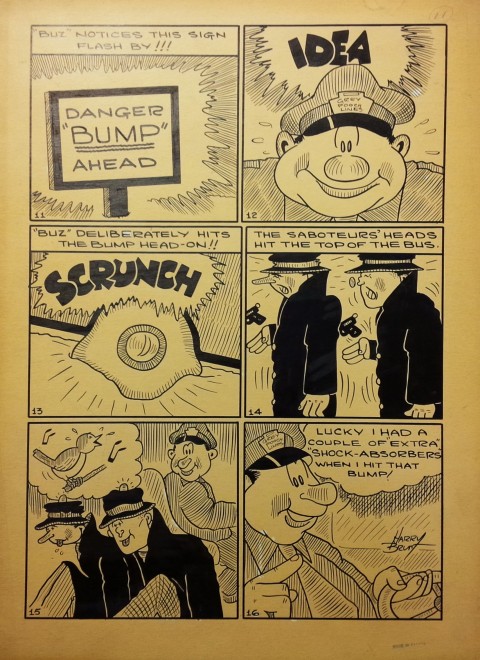
Among the books included was a Joke Comics 14 which features the first Wing cover and is a revival of John Hilkert’s Wing character by Jerry Lazare after two earlier appearances in Joke Comics 4 and 6. There were nice copies of Commando Comics 2 and Wow Comics 13, both with great Edmond Good covers, and a great Wow Comics 22.
Three other books that stood out for me in this collection were a Triumph 12, Joke 16, and a rarely seen Thrilling Stories for Boys which contains a collection of text stories from the Bell books and belongs to that same set of books that include the Nelvana and Speed Savage 1945 compendiums.
This week I myself received a couple of nice surprises in the Christmas mail as well. My friend Mel Taylor in Waterloo was kind enough to send me a beautiful copy of the book Tecumtha illustrated by Adrian Dingle. This was very kind of you Mel and I’m indebted to you. See Mel’s take on the whites back in my column from July 30th of this year.
Also in the mail this week was a signed copy of Jack Tremblay’s new comic book venture called Esthetic Comics. This is a digest sized 24 page comic put out probably in a very limited number. This was sent to me by Jack’s son Rick Trembles who was in Toronto last May with his father when Jack Tremblay was inducted along with Gerald Lazare into the Giants of the North Hall of Fame, part of the Doug Wright Awards that were presented at TCAF (see my post from May 14).
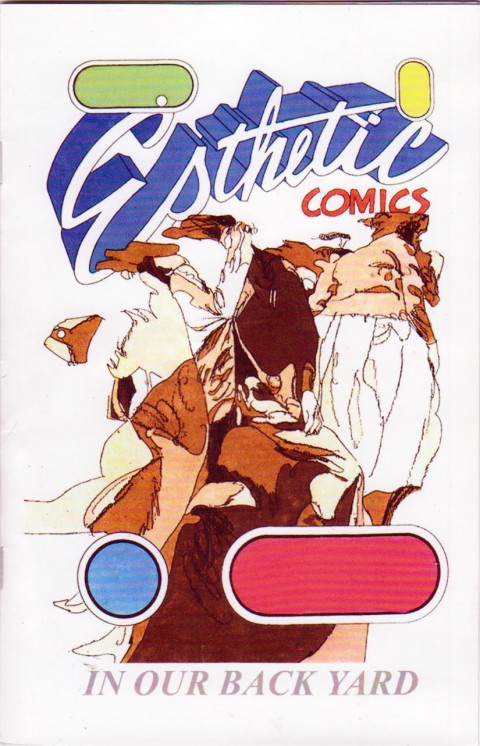
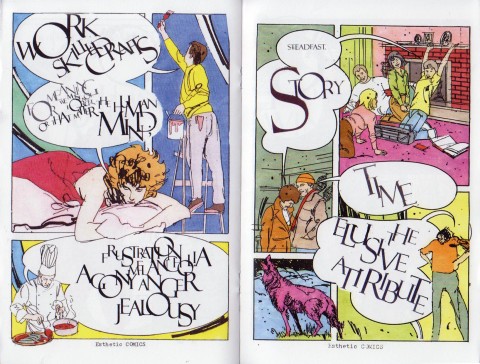
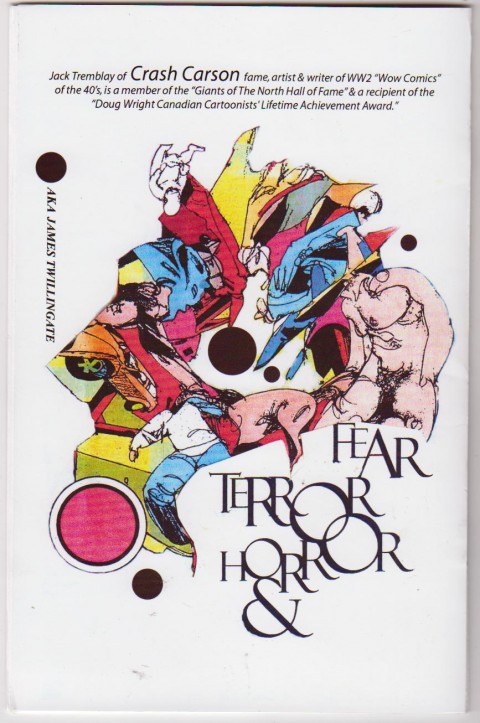
This is Trembay’s first work in comics in 70 years, a lacuna that’s probably a record in comics as is probably the fact that he has put out a comic as an 88 year old. The contents of Esthetic Comics a surreal dream journey into Jack’s head that is anchored to the page here and there by a carefully chosen word or short phrase—a true artist producing the kind of comic that recalls some of the underground efforts of the early seventies and more. Rick Trembles offers up some more details, including ordering information, about his dad’s comic here.
Now I’d like to share a couple of strange things that have come across my WECA desk recently and see if any of you can throw in your two cents on them.
The first is a Canadian edition of the American Exciting Comics No. 35 with the bulldozer Schomburg cover that’s from Oct.-Nov. 1944.
The Canadian edition has No. 39 on the cover but the thing I find interesting about it is that the indicia state that this reprint was done in Toronto by Publication Enterprises Limited (a company previously unknown to me) and that its publication date is March-May 1945, before the actual end of the war.
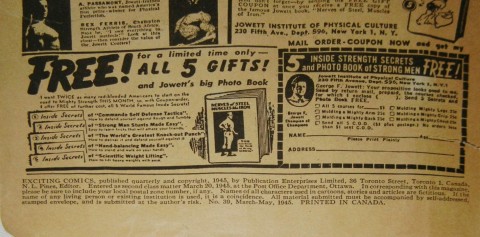
Now, to my knowledge, The War Exchange Conservation Act was not begun to be repealed until after the war was over. Victory over Europe (VE day) happened on May 8, 1945 and Victory over Japan (VJ day) on August 14, 1945. How does a Canadian company publish a wholesale reprint of an American comic with the War Exchange Conservation Act still in full effect. This is as much a mystery as the March, 1941 reprints of the four Fox titles 4 months after the War Exchanges Conservation Act was brought in by parliament and really at the same time Canada’s own comic books started to appear for the first time. What theories can we propose for the appearance of this book before the lifting of the War Exchange Conservation Act?
The second is a copy of Dime Comics No. 25 that I have just acquired with a cover by Clayton Dexter. You might remember a strange looking cover of The Funny Comics No. 7 that belonged to Manny Easson and hadn’t been processed through the impression of the colour yellow in my post from a couple of weeks ago. Well this copy of Dime 25 has missed out on the impression of the blue colour plate and therefor, again, is quite different from the other copy of Dime 25 I have.
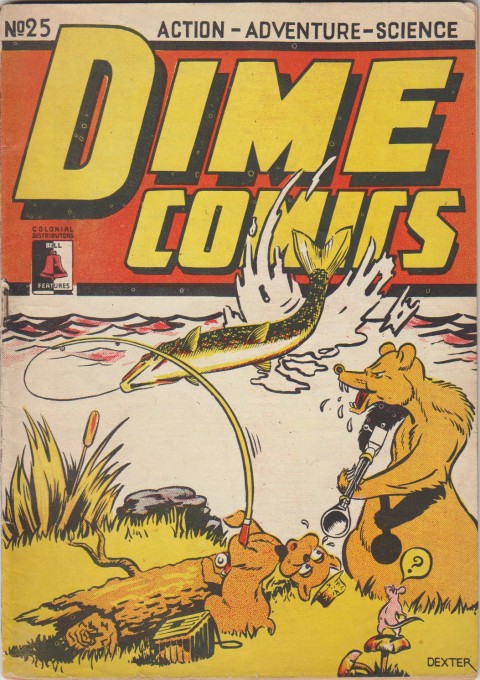
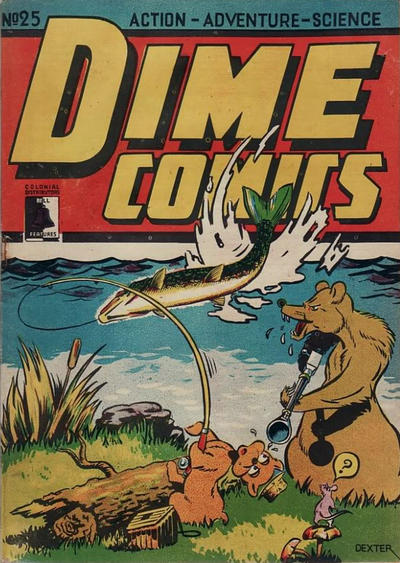
I thought the white cover Funny Comics No. 7 might have been a one-off caused by the actions of Manny Easson himself, but now should we consider these variants as more common? On top of this, if I sent this book to CGC for slabbing would it be recognized as a variant, that is, would they have the expertise to recognize this as a variant unless I spelled it out for them and even then would they acknowledge it?
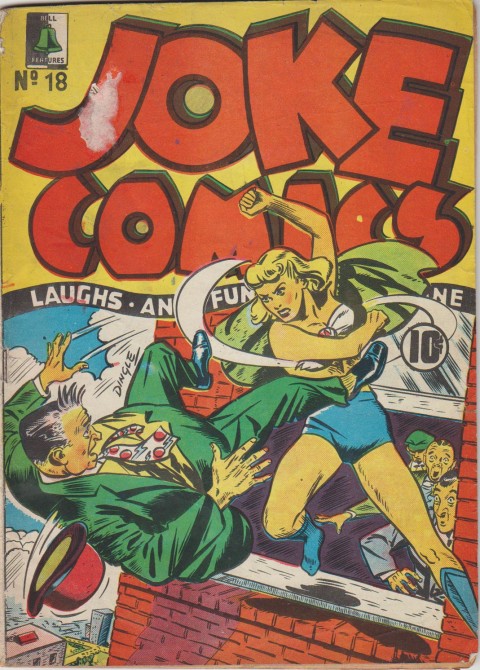
The last anomaly I hadn’t been aware of before involves two recently acquired copies of Joke Comics No. 18. This has a well-known Wing cover but the strange thing about them doesn’t involve the cover, at least not the front cover. The strange thing about these comics is that even though they are the same issue, their inside covers are different. Now I’ve previously found a discrepancy in inside covers in copies of The Funny Comics No. 19 where one had printed inside covers and one had blanks. The Joke 18s, however, involve two different printed inside covers.
One Joke 18 is trimmed and has tears along the spine which indicate that it is a copy that was one of five housed and glued together as the contents of an issue of Colossal Comics.
This copy has an inside front cover that advertises Collosal Comics and an inside back cover that has the big “V” ad for all seven Bell titles.
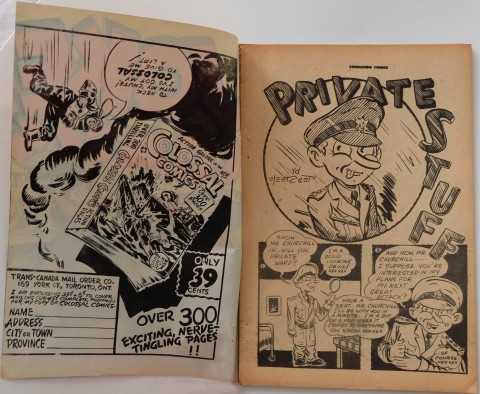
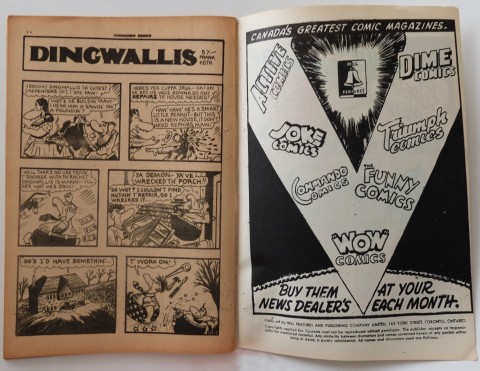
The other Joke 18 is just a regular, untrimmed copy and has a familiar ad for a buyback of old issues at the price of 50 cents each. It’s curious that Cy Bell and the boys only wanted these certain issues. The inside back cover for this copy of Joke 18 has an ad for Colossal Comics that is different from the trimmed issue just mentioned.
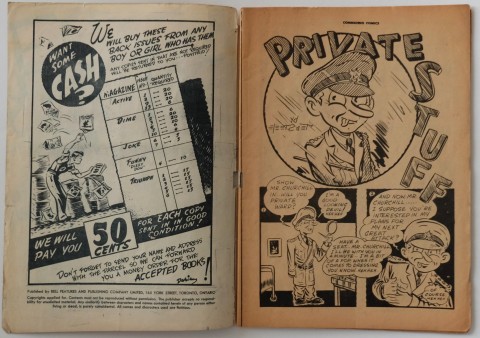
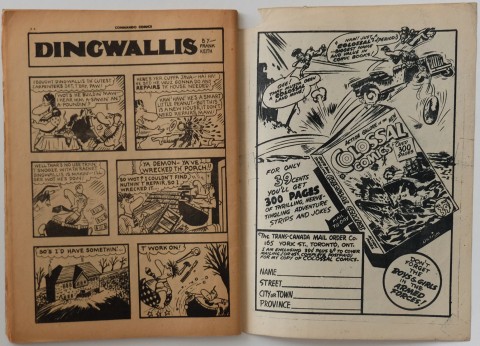
Is this just an indication of the fact that there might have been multiple printings of some of the Bell Features books or is there another possible explanation?
It’s Christmas Eve and I wish everybody the happiest of holidays and the best of luck in coming across those scarce and elusive WECA books in the coming year. Remember when you read comics, it’s Christmas every day.
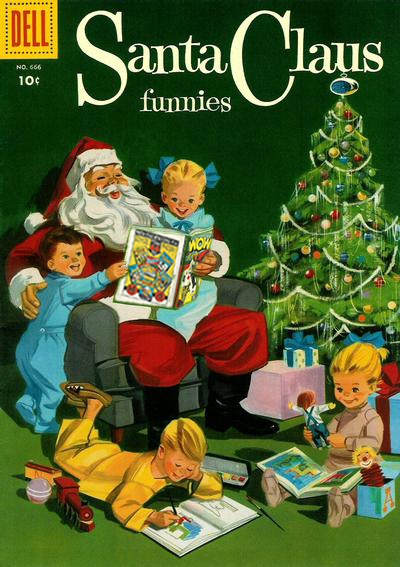

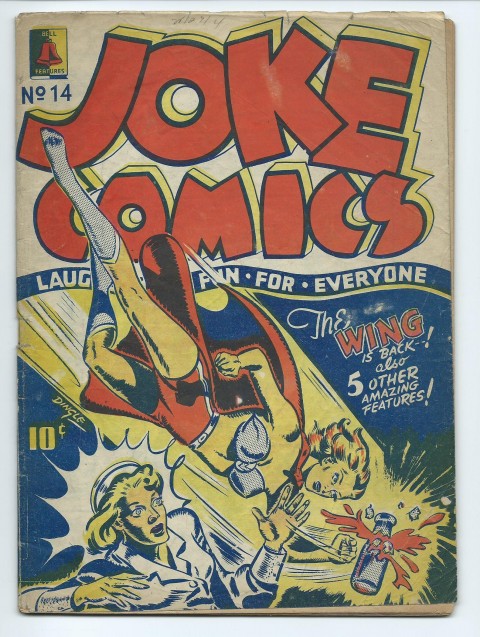
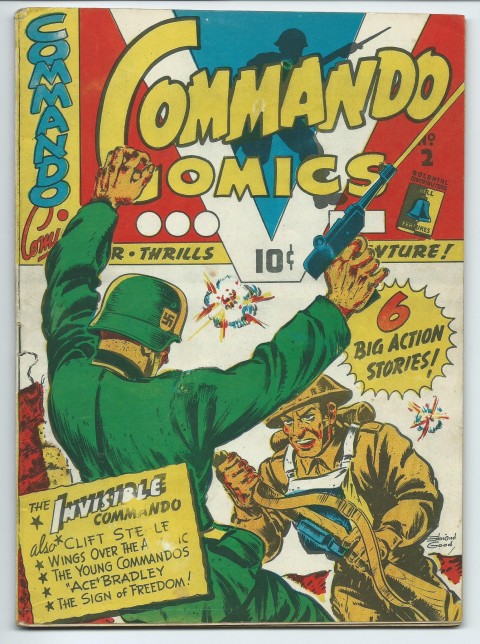
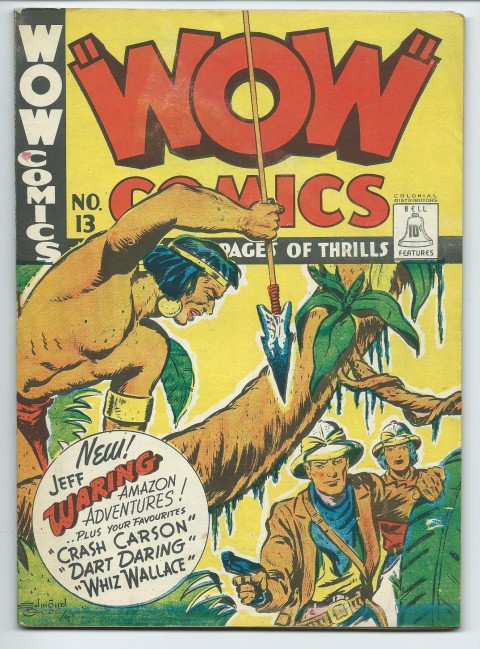
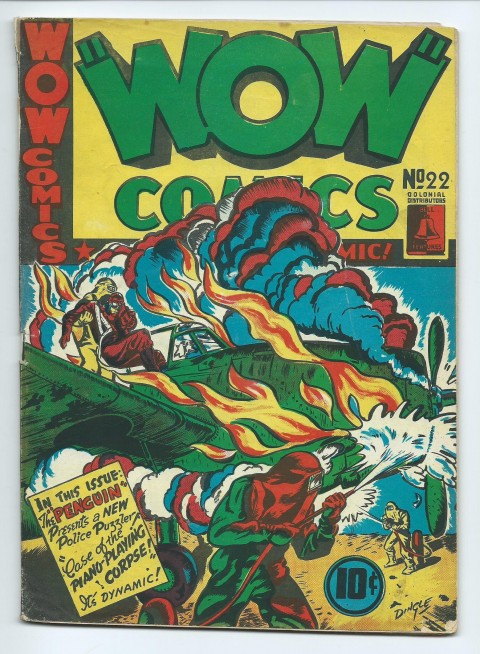
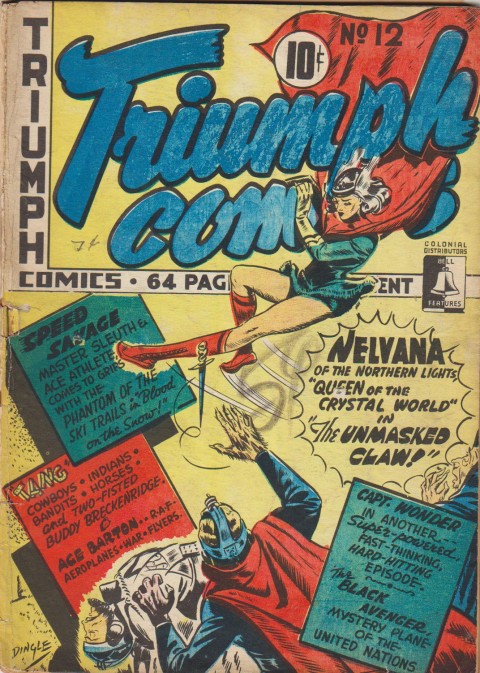
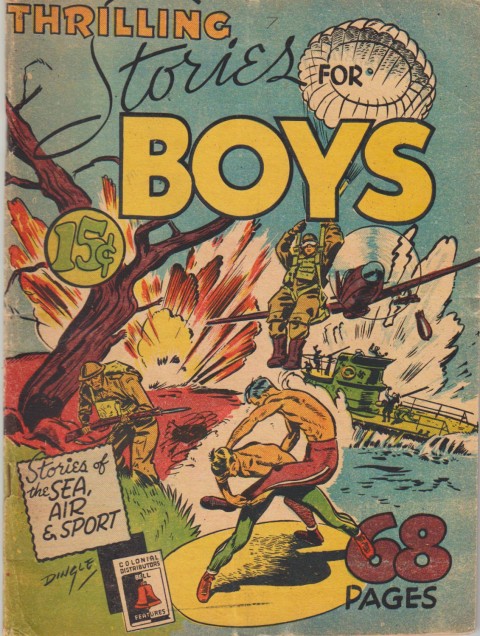
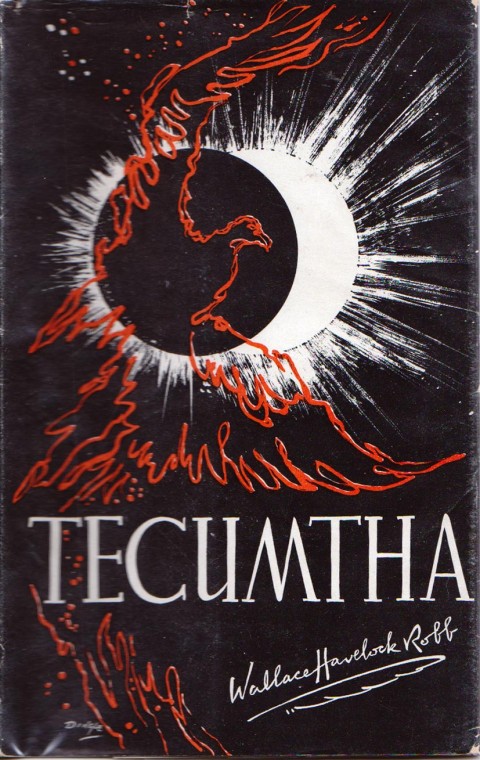
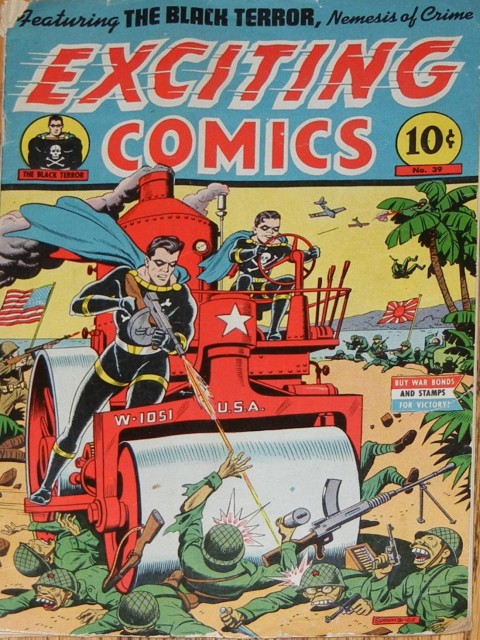



Hey Ivan
Glad you liked your copy of Tecumtha. The real icing on the cake is that I was able to pick up that and a copy of Logging With Paul Bunyan, also illustrated by Dingle, from the collection of the late, great comics collector and historian John Balge. John’s contribution to the history of the WECA period is best represented by his work in Harry Kremer’s Now and Then Times. With comic creator Dave Sim he conducted interviews with a number of WECA-era artists long before they became the stuff of comics legend. He will be sorely missed, and I am glad that I could give you a memento of his passing.
And, I’m not going to tell you who I have saved that lump of coal for. : )
Happy, happy. Joy, joy.
Thanks for chiming in, Mel. Ironically, the comics mentioned in this post were John Balge’s collection. John’s brother, Vince, got in touch with me a few weeks back because he found a letter of mine in John’s effects (remember that letter I brought with me for John on the first day I met you with Walt the day we came to see your comics exhibited at the Museum–I left it at Carry-On Comics and it must have got to him). Anyway, Vince sent me a list of WECA comics he’d found in John’s stuff and there were just over 45 comics. A couple of weeks ago I phoned Vince and found out that there were a few people (read dealers) interested in purchasing the set. I explained to Vince that I was just a collector and not a dealer and couldn’t really compete against dealers. I gave him the top limit of what I could pay and that he’d get the best price from me by letting me come and pick out the books I wanted, but Vince wanted to sell the collection in one swoop. In effect, I had to back out of the purchase, but, in the end I found out that your friend and mine, Walter Durajlija, ended up being the winner of the WECA books as part of a much larger purchase of John’s collected items from Vince. In the end, I was able to purchase over 20 of the WECA comics as a lot from Walt last week, including that Triumph 12, white Dime 25, and the two Joke 18s pictured.I felt reluctant to mention that the books in the post were John Balge’s because it was Walt’s buy but I asked if I could reveal it in my reply to your comment, Mel, and Walt was OK with this. It’s an honour to have John’s copy of Tecumtha and to have some of his comics.
Hey Ivan
Well, on the one hand, I am glad to know that you have some of John’s books, but, on the other hand, it pains me to know that Walt has already broken up the collection. One always hopes that personal collections such as John’s might stay together as a lasting tribute to the collector. Oh well, just another misconception I have to put aside. The market dictates the rules. Not the dreamers.
Your question ” How does a Canadian company publish a wholesale reprint of an American comic with the War Exchange Conservation Act still in full effect… “? It doesn’t.
The simple answer here for the intent of your question is that the War Exchange Act was not in full effect any longer. In fact the restrictions were relaxed on August 1, 1944.
Periodicals and other import items trickled in for a few months after that date until by the end of the 1944 year it was reported that some items (jewelry, toiletries, furs, games and card tables, glassware, whiskey and periodicals had been coming into Canada in almost pre-war levels. By the beginning of 1945 you could see Detective Comics and Superman on the newsstands beside copies of Better Comics and Active Comics.
(fyi: See writer Peter Harris’ mention of this in the loc of Mr. Monster for an eye witness account of the return of the U.S. comics where he discusses buying Super Duper #3 when it was new.)
If you want to read more on the relaxing of imports to Canada, you could start with “World Trade Policies: The Changing Panorama, 1920-1953” by Henry Chalmers.
Which makes that a whole other question as at that time you could also see copies of Nedor/Standard books like Exciting Comics, Thrilling and Real Life Comics on a Canadian newsstand. I gather these were the American editions.
Whew, that was longer winded than I intended, but I wanted to make it all clear that this was going on before VE Day.
Mel, I do agree with you in trying to keep significant and representative collection together, but the best way to do this is to donate them to an archive. I have seen archival collections which have a donor’s name attached to them and those which are anonymous. Our friend Robert MacMillan plans to donate his impressive collection of Whites to an archive and this will indeed keep his accomplishment together. John’s brother, Vince, did want to sell John’s items as a single lot, but if he had wanted to keep the collection together he would have donated it to an archive. On the other hand, an argument that some collectors make is that donating books to an archive is a negative action because it takes these books out of collecting circulation. All I can do is promise to treat John’s books with the greatest respect and reverence.
Thanks for your informative points, Jim, and they do express a possible explanation of some American comics being published as Canadian editions in Canada before the end of the war, but I’m respectfully not quite ready to accept your assertions until I can find proof of them myself. I do have a Globe and Mail article from July 22, 1944 which states the War Exchange Conservation Act restrictions will begin to be relaxed on Aug. 1, 1944, but this didn’t open up the doors for items to flood into Canada. It did mean that you could go across the border into Buffalo and bring back somethings you couldn’t before up to the limit of $75 Canadian, but it was still prohibitive for companies to import large quantities of most items into the country and make a profit.
I still don’t believe you could see Detective Comics and Action Comics on the stands in early 1945 and in all of my years of collecting the earliest copies of Canadian published Detective and Action Comics I’ve been able to find are from the beginning of 1948 and in all my years of collecting that copy of Exciting Comics is the only 1945 Canadian published American title that I have found. Remember that Super Duper 3 came out in May of 1947 so that Peter Harris is not remembering seeing Canadian reprints of American books during the war. Henry Chalmers account of the relaxing of WECA restrictions does not add anything as to when comics actually began appearing on the stands in Canada. It would be great to find out what the earliest Canadian reprint of an American book in 1945 or 1946 anybody else has. Mine is that March, 1945 issue of Exciting comics. American comics (non-reprinted titles) could have appeared on stands before VE day, but I don’t think a Canadian importer would have made it work at a profit before the war was over. Let’s wait until we have some firm evidence to see which one of us is closer to the truth. You may be right in the end, Jim, but I’m not fully convinced yet,
Well, I do have photo-graphic proof of this from magazine stands of the era, and then there are other records stating this, such as the December 1944 issue of Billboard magazine that you can find online.
But by all means, investigate it yourself. I had to do it, as it was all before my time.
By the way Ivan, I’m not trying to say that that issue of Exciting Comics isn’t an anomaly, or that there were American comics published up here. Just that comic books and magazines from the U.S. were coming into the Canadian marketplace in the Fall of 1944 onwards, after the trade restrictions were relaxed on some items.
One photograph I’ve seen has not only Bell and Maple Leaf comics on the same shelves as DC comics but also a March ’45 Captain America and the March issue of Anglo-American’s Captain Marvel (v4 #3) for example.
Thanks for adding to this, Jim. Given what you say, I see what you mean, that it’s probable that once a crack was opened in the WECA door on Aug. 1, 1944, American comics could start appearing on the stands next to Canadian comics and if you’ve seen photos to support this, then they probably did. I wonder who (which company) made an arrangement to import them and if the prices on them stayed as the American cover price? It was probably not a very profitable enterprise giving shipping costs and duty limits that would have still existed. It certainly would have started to send fear into the spines of the four major Canadian comic publishers of the time a lot earlier than I previously thought. I’ll use your information and keep searching for more to see if I can add to or clarify anything.
Sadly, in any estate settlement (I’m in the middle of one right now) the interests of all parties must be considered, and Vince has siblings to deal with, so it must have been necessary to sell assets to settle with all parties. The fact that he wanted to keep the collection together indicates to me that he saw the wisdom in this, and sold to an interested third party who was most likely to consider the integrity of the collection. Unfortunately that was not the case. I’m not blaming anybody. Let me be clear on that point. But, once those books hit the “market” it was anybody’s guess where they might end up. I understand too that you have the utmost respect for these collections, but I still feel the whole shebang would have been nicer as a unit, as Bob MacMillan’s collection will be one day.
all the best, mel
I have a link to some photographs posted on the CGC forums showing a newstand in Vancouver on Aug 1, 1944
Link:
http://boards.collectors-society.com/ubbthreads.php?ubb=showflat&Number=2275780&fpart=93
Hope this helps.
Cheers,
Stephen
Thanks for the link to these photos, Stephen, but I think that they must be from around May, 1944 and not Aug. 1944. We can clearly see a Commando Comics No. 11 in the third photo and what I believe to be a Wow Comics No. 20. In this third photo I think you can also see a “D” that begins “Dizzy Don” in a Funny Comics No. 12. The Dime mastheads you can make out must be from No. 15. These are all from April/May or May/June 1944. There is also an “L” from the Lucky Comics masthead being from an issue from the same time which must be Vol. 2 No. 10. True Comics, because they were more educational and history based was an American comic that was never included in the general ban on American comics.
Thanks for this great Christmas present of comics discoveries and historical research, everyone. Those photos of Vancouver newsstands are fantastic. My impression from this post and the comments is that Canada remained the Wild West of comics distribution and publishing for the entirety of the 1940s!
My own view is that the breaking up of collections is a shame, especially when the archival option is a reality. Sharing with a large audience and future generations is a greater good. I recognize that collectors are the only reason these books have made it this far and I am unwilling to test my own convictions in the face of the opportunity to either purchase or resell for a hefty profit a similar large collection…
Cool link, thanks for posting that Stephen.
The fifth photo down looks like it’s from around Jan. 1945, it has lots of March ’45 comics on the rack. A larger version of this can be found at the archives in Vancouver.
Wild West, eh Bryan? I like it!
Well, I did meet the Cisco Kid himself at the C.N.E. grandstand when I was small, and I’ve been to Boot Hill in Tombstone, so does this help in being a historian of Canadian comics then?
Yippee ki yayy!
Ivan, I have an America’s Best #14 Canadian edition. It is actually a reprint of the American #12, but has #14 on the cover with NO month date. Indicia states: “published quarterly and copyright 1945 by Publication Enterprises, 36 Toronto Street, Toronto 1, Ontario, Canada.” “No. 14, March-May, 1945 PRINTED IN CANADA.”
I wish this was a nice “smoking gun” with an earlier date than yours, but looks like nearly exactly the same period in early ’45.
Regarding variants: I have to take issue with you about considering a lack of one color in the cover printing–or even a blank inside cover–as being a possible variant. In my experience with underground comics in the late 1960s and early 1970s (and other printing in general), this happened a lot. In the old days, each of the four colors on the covers represented a separate “pass” through the printer. And the (usually) black inside cover was yet another pass, a 5th time through the press. Now days most presses can do all four colors in just one pass, and often on both sides of the paper.
But back then, it meant if two pages happened to come the press through stuck together, as you sometimes find happens with a printer or fax machine even today, it meant only the top copy got the color laid down. The bottom one didn’t. Thus, often we find copies with any of the four colors (black, cyan, blue, yellow) missing. I used to put these aside, and a few guys even collected them. And the same can happen with the back side, the black inside covers plate. Two pages stuck together again, even more likely because they now have 4 colors the reverse side.
But I have to insist they are not variants…they are simply misprints. A variant to me should be a clear change in the output directed by the printer…say if an edition actually drops a color, from three color to two color, for instance. Larry Lowery (The Big Little Book Club) has documented Penny Books (an offshoot of Big Little Books) where publishers indeed did that, to save a fraction on each copy as they did 2nd or 3rd printings of very inexpensive items.
It is great to see you still posting. I loved the Stephen Lipson interview and especially the link to his collectiion of covers, which I had not known about before. That was really fun to scroll through. And I’m going to look for that new Jack Tremblay comic, it’s odd but kind of intriguing. I’m not always a fan of playing that much with type sizes, but he seems to do it with an elegance that may show he really understands page design and telling a story.
Very Best, Bud
Thanks for your insight about dropped colours and inside covers. It does make sense. These should be seen as misprinted comics and not variants. I know with coins that mis-stamped versions are very collectible simple for their scarcity compared to the common issue and as you say this could make an esoteric collecting sideline for some collectors and perhaps a must have for some completists. The two different inside covers for Joke 18, however, do seem to make them one of them a proper variant. Thanks for sharing your experience in this area, Bud.